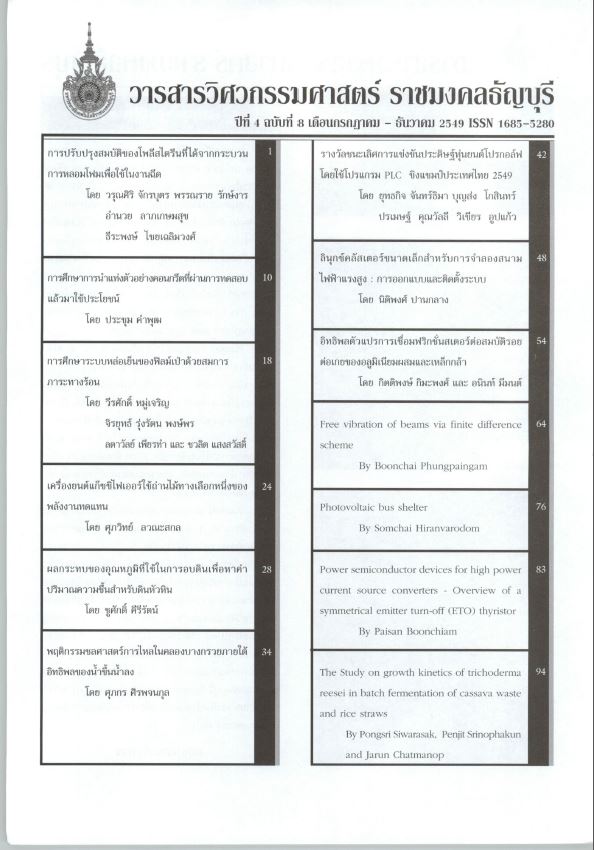Power Semiconductor Devices for High Power Current Source Converters-Overview of a symmetrical emitter turn-off (ETO) thyristor
Main Article Content
Abstract
This paper presents the development of an power semiconductor device for the high power current source converter (CSC). The CSC is very attractive in high power applications due to its lower output dv/dt, easy regeneration capability and implicit short-circuit protection. Traditionally. either a symmetrical gate turn-off (GTO) thyristor or an asymmetrical GTO in series with a diode is used as the power switch in the CSC. Since the GTO has a lower switching speed and requires a complicated gate driver. the symmetrical GTO based CSC usually has low dynamic response speed and low efficiency. To achieve high power rating. fast dynamic response speed and low harmonics, an advanced semiconductor device are needed for the CSC. Based on symmetrical GTO and power MOSFET technologies, a symmetrical emitter turn-off (ETO) thyristor is developed that shows superior switching performance, high power rating and reverse voltage blocking capability. Based on a six-switch CSC cell, the multilevel CSC has the advantages of high power rating, low harmonics. fast dynamic response and modularity. Therefore, it is very suitable for high power applications.
Article Details
The manuscript, information, content, picture and so forth which were published on Frontiers in engineering innovation research has been a copyright of this journal only. There is not allow anyone or any organize to duplicate all content or some document for unethical publication.
References
Alex Q. Huang. "Power Electronics Hand book-Power Semiconductor Devices," 2003.
B.J, Baliga, "Power Semiconductor Devices," PWS Publishing Company, 1994.
Narain G. Hingorani and Laszlo Gyugyi,"Understanding FACTS, Concepts and Technology of Flexible AC Transmission Systems," Institute of Electrical and Electronics Engineers, New York, 2000.
B.J. Baliga, "Trends in Power Semiconductor Devices," Electron Devices, IEEE Trans., Volume: 43 Issue: 10, pp. 1717 - 1731.
Steven C. Rizzo, Bin Wu and Reza Sotudeh,"Symmetric GTO and snubber component characterization in PWM current- source inverters,'' IEEE PE, July 1998, pp. 617-625.
P.M.Espelage, J. M. Nowak and L. H. Walker,"Symmetrical GTO current source inverter for wide speed range control of 2300 to 4160 V,350 to 7000 HP, induction motors," IBEE IAS,1988, pp. 302-307.
F. Auerbach, J.G. Bauer, etal., "6.5 kV IGBT-modules,' IEEE Industry Applications Conference, 1999, Oct. 1999, pp.1770 -1774.
HC. Eckel, etal., "Optimization of the Turn-Off Performance of IGBT at Ove.current and Short Circuit Current," 5h European Conference on Power Electronics and Application Rec. 1993, pp. 317-322.
H.A. Schafft, "Second Breakdown A Com prehensive Review", Proc. IRE, Vol. 55 1967, pp. 1272-1288.
P.L. Hower and V.G.K. Reddi, "Avalanche Breakdown in Transistors," IEEE Trans. Electron Devices, Vol.ED-17, 1970, pp.320-335
B.R. Pelly, "Power MOSFET'S A Sa.Review", International Power Electronic Conference Record, 1983, pp. 19-32.
B.J. Baliga, M.S. Adler, R.P. Love, P.V. "The Insulated Gate Gray and N. Zommer,Transistor: A New Three Terminal MOS Controlled Bipolar Power Device," IEEE Trans. Electron Devices, Vol. ED-31, 1984,pp. 821-828.
s. Bernet, R. Teichmann, A. Zuckerbere and P. Steimer, "Comparison of High Powe.IGBTs and Hard
K. Sath, M. Yamamoto, K. Morishita, Y Yamaguchi and H. Iwamoto, "High power symmetrical GCT for Current Source Inverter," IEEE PEDS'99, July 1999, p.877-882.
H. Gruening, B.Odegard, J. Ress, A. Weber,E. Carroll and S. Eicher, :High power hard-driven GTO module for 4.5-kV/3-kA snubberless operation," PCIM 96, pp. 169-183.
Jochen von Bloh and Rik W. De Donker,"Characterizing medium-voltage high-power devices under conventional and soft-switching conditions," IEEE IAS, 1999, pp. 373-378.
J.D. Ainsworth, M. Davies, P.J. Fitz, K.E. Owen and D.R. Trainer, "Static var compensator
(STATCOM) based on single-phase chain circuit converters," IEE Proceedings- Generation, Transmission and Distribution, July 1998, pp.381 - 386.


